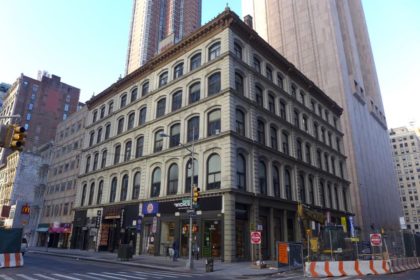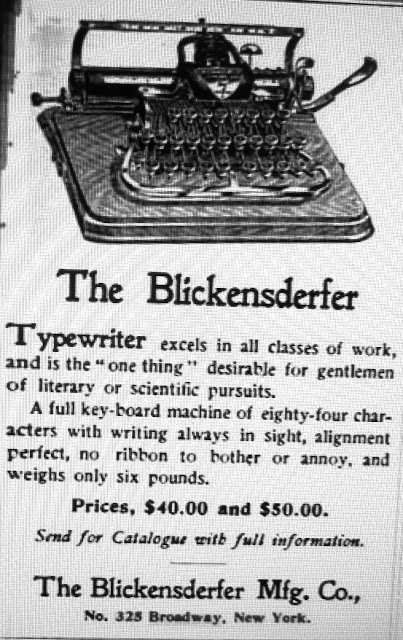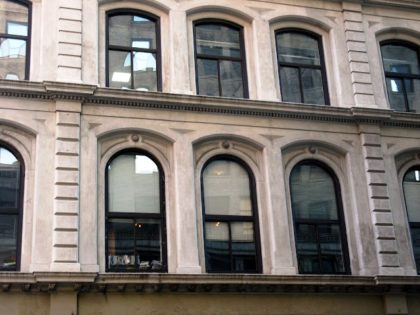The History of 325-333 Broadway
 Tom Miller, who writes about the history of Manhattan buildings at Daytonian in Manhattan, has allowed Tribeca Citizen to create a database of his Tribeca posts. If you enjoy these, and you will, then you should definitely check out his website, which also has write-ups about buildings all over the island. And don’t miss his book, Seeking New York: The Stories Behind the Historic Architecture of Manhattan—One Building at a Time.
Tom Miller, who writes about the history of Manhattan buildings at Daytonian in Manhattan, has allowed Tribeca Citizen to create a database of his Tribeca posts. If you enjoy these, and you will, then you should definitely check out his website, which also has write-ups about buildings all over the island. And don’t miss his book, Seeking New York: The Stories Behind the Historic Architecture of Manhattan—One Building at a Time.
··································
 With the outbreak of the Civil War, the textile industry in New York, centered in the Broadway and Worth Street area, flourished with the increased demand for uniforms, blankets and other such military supplies, coupled with the wartime tariffs on foreign-made apparel.
With the outbreak of the Civil War, the textile industry in New York, centered in the Broadway and Worth Street area, flourished with the increased demand for uniforms, blankets and other such military supplies, coupled with the wartime tariffs on foreign-made apparel.
Henry Barclay had inherited his father’s substantial real estate holdings in Manhattan and Queens. In the 1840s the younger Barclay had constructed three five-story buildings at the southwest corner of Broadway at Worth Street. Now the potential profits to be made during this prosperous period prompted him to raze the relatively new buildings and replace them with grander structures which would command higher income.
At the time, cast-iron facades were becoming more and more popular with builders. They were relatively inexpensive, eliminated the need for stone carvers, and imitated the look of neighboring masonry buildings. Henry Barclay was not interested in “inexpensive” or “imitation.”
Begun in 1863 and completed a year later, the three five-story buildings were clad in gleaming white marble. Designed to appear as a single structure, they offered retail space on street level with manufacturing lofts and office space above. The Renaissance-inspired buildings stretched from No. 325 to No. 333 Broadway and Barclay’s conservative approach to architecture—expressed in his rebuff of cast iron—reflected itself in the overall, reserved design. The resulting structures were restrained, dignified and quietly elegant.
Among the first tenants was the firm of Elliot C. Cowdin & Co., importers and dealers of “French fancy goods.” The company leased the entire fifth floor of No. 327. With most of the men away at war, young girls like Angelina Portlippi and Josephine Thompson filled the workspaces of shops. They pair made artificial flowers for Cowdin. On April 16, 1863, tragedy would visit the new building.
In order to easily move goods vertically through the building, a shaft was constructed with sliding hatch covers on each floor. Goods in the basement or delivered to the ground floor could be hoisted up to the upper floors rather than being lugged up stairs. The teen-aged girls (Angelina was 18 and Josephine a year older) were horse-playing as they prepared to leave work at 5:30 that afternoon. Somehow the hatchway slid open and the girls plummeted to the cellar five floors below to their deaths. In reporting the heartbreaking story, The New York Times noted, “Both of them are said to have been girls of industrious and steady habits, and of respectable parentage.”
By the 1880s, textile companies were giving way to stationery-related firms. In 1888 Pace Dennis & Co. was here, sellers of Howe Scales. The would remain through the turn of the century.
Bullock’s Brothers was headquarters at No. 325 at the time, manufacturing the “Perfection” Elastic Blotter. At a time when ballpoint pens were unheard of, blotters were a necessary desk accessory. Bullock’s promised that the elastic blotter required “No rocking or rolling. Simple pressure operates. No stationer’s stock complete without.”
Also here in 1889 was Sillcock’s Brothers, manufacturers and sellers of “specialty celluloid goods.”
Office work was being revolutionized around this time by the introduction of the typewriter. (Interestingly, the operators of the machines, later called secretaries, were also referred to as typewriters.) In 1899, Blickensderfer Manufacturing Company took over the entire building at No. 325. The company announced its move in The School Journal and noted that as well as selling its Blickensderfer typewriter, it was the sold agents for the Tucker Card Index System, Tucker Suspension Letter and Document Files, and the Wells Letter and Catalogue Files.
Regarding its own typewriter, Blickensderfer noted that “The schools are using them. They are light, neat, clean and have a never-wear-out quality. Do as good work as the high-priced machines, and are easier to handle.”
 In 1900 a Blickensderfer machine was pricey—about $1000 today.
In 1900 a Blickensderfer machine was pricey—about $1000 today.
··································
While Blickensderfer was promoting its new typewriters, Wickoff, Seamans & Benedict had been next door at No. 327 since around 1888 selling the highly-touted Remington typewriter. In 1892, King’s Handbook of New York spoke of the firm’s “executive offices and main selling headquarters” in the “plain and unpretentious, though substantial marble structure” at No. 327 Broadway.
The firms were major competitors. Directly next to a Blickensderfer advertisement in Education Magazine in 1900 was one for Wickoff, Seamans & Benedict. “Solid merit is the foundation on which is built the enduring fame of the Remington,” said the ad.
Wickoff, Seamans & Benedict would win out. In 1905, the company changed its name to the Remington Typewriter Company and about five years later leased the entire block of buildings from No. 325 through No. 333. Internal renovations were made, creating a single building. While Remington took nearly the entire structure, it still rented space to firms like the Smith-Premier Typewriter Co. (which would later become Smith-Corona).
Smith-Premier was charged with producing orders for munitions of war for Germany in 1915 by George Sylvester Viereck, the editor of The Fatherland magazine. Mason Wheeler, the vice-president of Smith-Premier wrote a curt and succinct letter to the periodical on April 27:
“Replying to your favor of the 24th inst., we have refused to consider orders for arms and ammunition finding it to our best interests to confine our plants to the manufacture of typewriters and typewriter parts.”
By 1917, Remington Typewriter Company had grown out of the space. That year it moved further north to No. 374 Broadway. With Remington’s removal, the building once again became home to, mostly, textile and dry goods firms (although in 1919 Keene Co. was here, exporters and importers of “chemicals and drugs, citric acid, tartaric acid, cream of tartar, Prussian blue, creosote carbonate, quinine, morphine, codeine, etc.”).
Converse & Co., a dry goods commission agency moved in immediately and would stay for around two decades. M.C. D. Borden & Sons established its offices here, the selling agency for the American Printing Company—the largest cloth mill in the country.
In 1923 Borden & Sons purchased the building. Throughout the 20th century, the building continued to see textile firms, including Iselin-Jefferson Co and Dan River Mills, come and go.
 Despite decades of pollution and acid-rain, the carved marble detailing is remarkably crisp.
Despite decades of pollution and acid-rain, the carved marble detailing is remarkably crisp.
··································
Ironically, considering the building’s history, throughout the 1960s the city’s Department of Labor leased rooms in No. 325 where unemployed minority workers could practice typing, thereby heightening their marketability.
Today a variety of gritty shops inhabit the retail spaces, decorating the street level with flashy signs. Yet the Civil War period marble palazzo is remarkably intact. The original cast iron storefronts, somewhat altered, are still there along with the marble rusticated piers. Above little has changed in the century and a half that Henry Barclay’s building has stood.
··································
Photo credits from top: Tribeca Citizen; unknown; Alice Lum.













